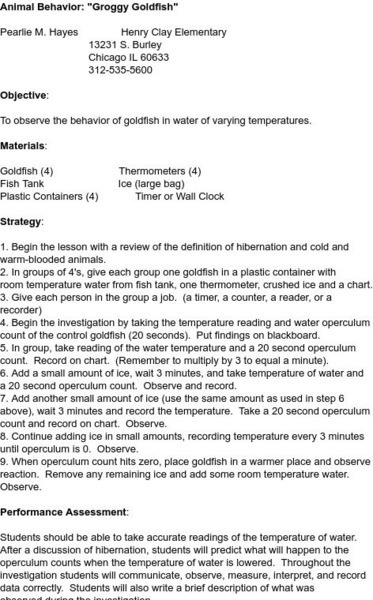Hi, what do you want to do?
Curated OER
Wonderful Whales
Primary marine biologists consider the largest living animals on Earth, the whales. Introduce them to general anatomy, unique adaptations, and behaviors. Teach them to sing a song that will help them remember some of these facts....
Curated OER
Science: Fish Behavior Bingo
Fifth graders, working in groups, observe fish in the Aquademics aquarium and identify the behaviors pictured there on worksheets. They match the pictures showing the behaviors, such as feeding, with the descriptions listed at the bottom...
Curated OER
Mountain Lions in Arizona Lesson 5: Humans and Lions - Encounters in Nature
Fledgling felinologists are taught how to recognize when a mountain lion is preparing to attack. They identify proper actions to provide the greatest chance of survival if they are attacked. Learners play a matching card game in which...
Curated OER
Seashore Limitations
Students demonstrate the movements and behaviors of creatures from different parts of the ocean.
Curated OER
Long Live the Sharks and Rays
Students study shark and ray adaptations that have helped their survival. In this animal adaptations instructional activity students view a video and work in groups to research specific types of sharks and rays.
Curated OER
Nature Superfish
Students study the behavior or ocean animals called billfish. In this life science lesson, students create their own documentary about a local animal. They share their videos with the entire school.
Curated OER
Pets
Young scholars participate in an after school program that promotes making decisions, getting along with others, decision-making, and being responsible. A pet survey is administered along with a variety of pet riddles with the students....
Curated OER
Survival of the Fittest
Sixth graders create their own "never before seen" marine creatures and examine how not all creatures in the sea swim, not all have sharp teeth
Curated OER
Biomes: Adapting To Deserts & Other Ecosystems
Students examine how animals must be adapted to the conditions of its environment to survive. In this biomes lesson students research desert adaptations then discuss how these animals have survived.
Curated OER
Metamorphosis Matching
Students view pictures of animals as they complete the metamorphosis from a larva to an adult. In this metamorphosis lesson plan, students view pictures and in the end are able to match pictures of a larva stage to an adult stage in...
Curated OER
Desert Animals
Students survive within an ecosystem, an animal must be physically and behaviorally adapted to the conditions of its environment.
Curated OER
Population Density
Middle schoolers use the scientific method to conduct an experiment and use varied methods to gather background information. They correctly use lab equipment and prepare tables and graphs that organize, conclude, and present their...
Curated OER
Biomes: Freshwater & Seawater
Students observe organisms behavior and adaptations. In this biomes activity students conduct fieldwork to determine water quality and answer questions about the differences between different habitats.
Curated OER
Are There Too Many Elk?
Students use information about elk populations in Arizona to make recommendations about population management. For this ecology lesson, students discover the problems associated with having a heard of elk that is too large. After...
Curated OER
Barnacles: Harder than Cement
Fourth graders watch the movements of the complex animal hidden inside the tiny barnacle shells. This lesson allows students to study the behavior, adaptation, and larval stage of the barnacle.
Curated OER
It Takes All Kinds!
Students view video clips and observe similarities and differences between animals. They sort animals into groups for a zoo. They make a graph of their observations and review scientific classifications.
Curated OER
From Polliwog to Frog
Students examine how frogs change. In this life cycle activity, students create a model to show how a frog changes throughout its life. Students will show the process of frog metamorphosis, from polliwog to adult frog.
Curated OER
Are There Too Many Elk?
Students study elk populations in Arizona. In this data lesson students read an article on monitoring elk populations, analyze data and make management recommendations.
Curated OER
Bats
Students model how the bones in a bat wing are organized. They develop questions about bat body parts based on photographs. They hypothesize how bats locate their food.
Science and Mathematics Initiative for Learning Enhancement (SMILE)
Smile: Animal Behavior
Lesson plan that allows students to investigate the effect of water temperature on fish behavior. Students measure, collect data, and interpret the results.
PBS
Pbs Teachers: Scientific American: The New Zoos: Tuna in the Tank
Investigate how scientists track the world's most valuable and endangered fish. Define the range of an individual based on observations made over the course of a day.

























